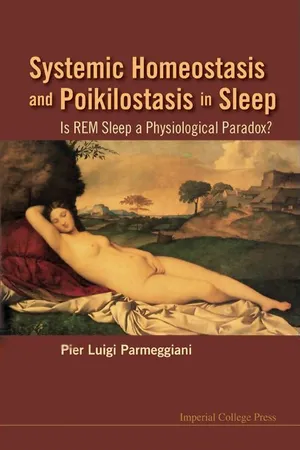
Systemic Homeostasis And Poikilostasis In Sleep: Is Rem Sleep A Physiological Paradox?
Is REM Sleep a Physiological Paradox?
- 140 pages
- English
- PDF
- Available on iOS & Android
Systemic Homeostasis And Poikilostasis In Sleep: Is Rem Sleep A Physiological Paradox?
Is REM Sleep a Physiological Paradox?
About this book
This book aims at presenting biologists and clinicians with a compact description of the physiological manifestations of sleep that are significant from the viewpoint of the principle of homeostasis. In the jargon of the physiological literature, the word "homeostasis", introduced by W.B. Cannon (1926), refers to the existence of a constant state of extracellular body fluids with regard to their physical and chemical properties. Since normal cell function depends on the constancy of such fluids, in multicellular animals there are many regulatory mechanisms under the control of the central nervous system that act to maintain the constancy of the internal environment.The experimental study of homeostasis in wakefulness already revealed the nature and complexity of the underlying physiological mechanisms. Many of these regulatory mechanisms trigger compensatory changes according to the principle of negative feedback. In contrast, the control of homeostasis across sleep states is still an issue under debate concerning its physiological persistence and significance. The author's aim is to find the specific mechanistic proofs of the actual consistency or inconsistency of the principle in different states of sleep. In this respect, there are several interacting physiological functions that ought to be examined across the sleep states. The selection of the most significant experimental data is carried out with a view to present a simple but not simplistic approach to the issue.The book brings forth the evidence that the systemic homeostatic regulation of many physiological variables underlying cellular life is not active in a particular state of the ultradian sleep cycle in mammals. It also shows the theoretical and functional importance of the principle of homeostasis, as a criterion of the systemic characterisation of the integrative control of physiological functions by the central nervous system during sleep in mammals.
Frequently asked questions
- Essential is ideal for learners and professionals who enjoy exploring a wide range of subjects. Access the Essential Library with 800,000+ trusted titles and best-sellers across business, personal growth, and the humanities. Includes unlimited reading time and Standard Read Aloud voice.
- Complete: Perfect for advanced learners and researchers needing full, unrestricted access. Unlock 1.4M+ books across hundreds of subjects, including academic and specialized titles. The Complete Plan also includes advanced features like Premium Read Aloud and Research Assistant.
Please note we cannot support devices running on iOS 13 and Android 7 or earlier. Learn more about using the app.
Information
Table of contents
- Contents
- Acknowledgements
- Preface
- Chapter 1 The Principle of Homeostasis
- Chapter 2 The Study of Homeostasis in Sleep
- Chapter 3 Respiration in Sleep
- Chapter 4 Circulation in Sleep
- Chapter 5 Temperature Regulation in Sleep
- Chapter 6 Influence of Temperature on Sleep
- Chapter 7 Compartmentalised Brain Homeostasis in Sleep
- Chapter 8 Ultradian Homeostasis–Poikilostasis Cycle
- Chapter 9 Systemic Physiological Regulation in the Ultradian Wake–Sleep Cycle
- Chapter 10 Epilogue
- References
- Index